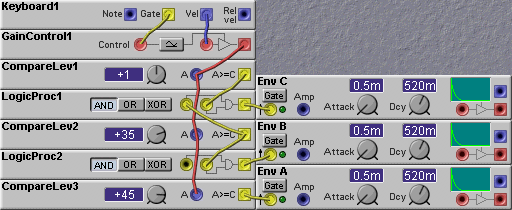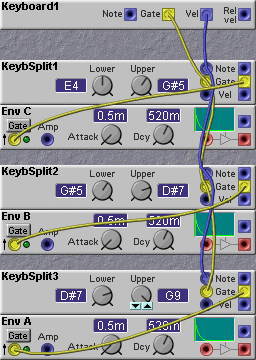 Velocity Split Trigger
Velocity Split Trigger Velocity Split Trigger
Velocity Split Trigger
As an example:
Rob Hordijk gave the following solution

Three compare modules are used to check the velocity. But the outputs of the compare modules are first put into logic processor modules that use the so called XOR function. The test is: if a compare module outputs a gate (velocity is greater that the threshold value), only pass that on if the higher compare module (the next higher threshold value) does notoutput a gate.
The manual (page 177):
This Logic Processor module transmits a high logic signal whenever any incoming signals meet a condition set by you. The input signals are considered "high" at any value equal to, or above, +1 unit. The transmitted logic signal will be high for as long as the incoming signals meet the condition. ... XOR produces a high logic signal when only one signal, with a level greater than 0 units, appears at one of the inputs.If the XOR function wouldn't be used, the velocity will trigger envelope C in the lower regions, in a higher value envelopes C and B will be active and slamming the keys will result in all three! XOR will stop the gate when there is another input, in this case a higher value, detected by another compare module. The velocity value is first passed through a gain controller module that acts as a gate controlled switch for the velocity value before entering the decoding (sub)patch. Note that a MIDI velocity value of 64 translates to 32 clavia units and 127 translates to 64 clavia units, so to set the threshold divide the MIDI value by two.
The manual (Page 178):
Compare Level This module produces a high logic signal by comparing a control signal level to a level limit set by you. If the value of a signal appearing at the input equals, or is greater than the value set in the window, the module produces a high logic signal. The logic signal will switch back to zero when the incoming signal drops to a level below the value set in the window. Level Limit Knob: Set the level limit for the comparison with the knob. Range: -64 to +64 units.For our example the threshold values on the compare modules would be 1, 35 (70/2) and 45 (90/2). The first threshold is set to 1 and not to 0, otherwise the first gate would also be on when there is no key pressed (a 0 value output from the gain controller). Anyway, sending a note with MIDI velocity value 0 means a MIDI NoteOff command, so 0 velocity can never be used to represent a key press.
Jan Punter gave a different approach

In the Nord Modular keyboards notes and velocity are Midi values. So you can switch them. (Manual Page 28) As velocity is an unipolar value, the detection, in this case the note input of a keyboardsplit module, can only be used between E4 (=Midi 0) and higher. Jan calculated the given above values as if they were keyboards values. The keyboardsplit module is a range detector: 'In the set range or not?' Instead of reading keys values it takes the velocity. Note the gate is used too, otherwise the module won't function. This demonstrates the flexibility of the Nord Modular system.
Kees van der Maarel suggested
[This a variation on the solution given by Rob Hordijk]
Doug wrote:
Which solutions act as gates, with note-off/release messages, rather than just triggers? Jan's -right?
Rob Hordijk wrote:
Not completely right, they all do. Kees' and mine solution are basically the same, the only difference is how the gate is processed, before or after decoding the velocityvalue. It all depends on what you want to do, so some examples to get the imagination going. Jan's solution is perfect for velocity switching like on a sampler where there are different samples for different velocity ranges, as the keyboard splitter samples and holds the note and velocity values internally (needed for the Amp inputs on the envelope modules). The Note outputs of the keyboard splitter must be connected to the Amp inputs of the envelope modules.
For the other solution you need S&H modules to hold the values at the Amp inputs of the envelope modules.
Jan Punter wrote:
I disagree
Rob Hordijk wrote:
If you would e.g. like to start different control sequencer modules (different patterns) to modulate e.g. filters depending on the velocity, you wouldn't need the velocity on the envelopes. Also you might not want the velocity value to be 'gated', so the keyboard splitter is of less use.
Jan Punter
also expresses his doubts here...Rob Hordijk wrote:
In this patch you might want to play a chord. For every note pressed, which modulation sequence is used is dependent of the velocity value of that keypress. As the length of the sequences is also different interesting pattern variations can be played.
If you really want to go extreme, and would like the velocity-thresholds to be dependent of changing values generated somewhere else in the patch, the compare to constant modules can be swapped for compare A to B modules. (VeloTest4.pch) This patch will give sound variations on repeating 'Clicktrack' notes from a MIDI sequencer or drum computer, where these notes are fixed. The pattern can be varied interactively with knob 1, 2 and 3 and the velocity value of the repeating note(s), and is also dependent of the LFO speeds. Some level shifter and control mixer modules are used after the LFO's, to be sure that the threshold values are always greater than or equal to the threshold values of a lower level.
These are just some examples to show the unsurpassed flexibility of the NM. IMHO you don't have to be exceptionally bright minded to figure out this kind of solutions. But what really pays off, is to go through all the modules one by one, testing them thoroughly and figure out what they could be used for. The trick is mostly in the combination of several modules, but to be able to make those combinations 'you must know your modules'. Although it is tempting to 'stick to your favorites', making time just to experiment is necessary. I was lucky to have lived in the period of the old analog modular dinosaurs (in my case i.g.. an Arp2500 system, timeshared with some others). In those days every few months there was the money to buy one more module and play with the added possibilities, until another new module arrived. That way you really learned what you could do with such a module, alone and in combination with the other modules and equipment present. Now we have an abundance of modules all at once, in virtually any quantity. That's an incredible richness, but also makes it much more difficult to know where to start.